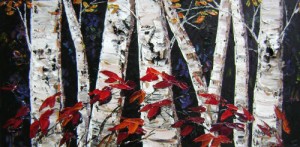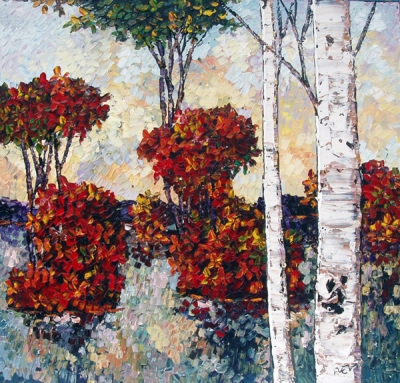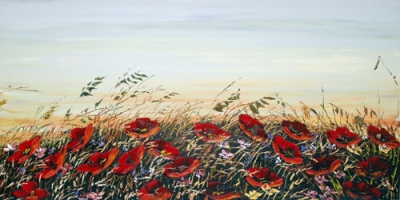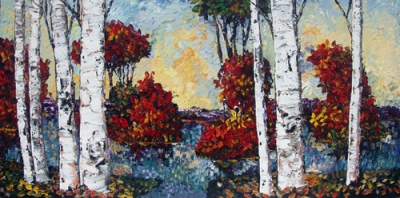Portrait of an Artist – Interview with Maya Eventov
by Joel Irwin
 Who have been the principal influences over your style?
Who have been the principal influences over your style?
Mostly the post-impressionists I would say. We had a great collection of them in the Hermitage museum in St. Petersburg, formerly Leningrad where I grew up. I often found myself wandering the halls there; my mom was a great fan of the post-impressionist period, and so I visited it often, probably every two or three weeks.
Have you adapted some of the post-impressionist styles to your own?
It’s hard to say where the influence of my style comes from; things sometime happen by mistake; sometimes some things just happen to you. All the information, the visual information that you’ve stored over the years becomes a part of you. I don’t like to label my styles as something certain.
What distinguishes your landscape paintings from others?
I think what distinguishes me most is my passion, my love for life, and everything I create in my mind. First of all, none of my works are preconceived; I’m not looking at any particular scenery; I don’t have any sketches in front of me. When I start my painting, it’s like writing a story – I create an idyllic landscape and imagine myself there. As I paint, it happens to me, so there is an element of unpredictability; it’s almost like an adrenaline rush when it happens and you create a place where you want to be, that ideal place. That emotion and passion that it creates in me is translated onto the canvas and makes something very distinctive.
So you don’t work from sketches?
No, I look at everything every minute, every second of my life and absorb them and they come out in my paintings at different times. Something I’ve seen years ago will become a part of the universe that I create for myself.
Having been born in St. Petersburg and having traveled throughout Europe and Canada, you must have seen a lot of different landscapes. Do you think that the different landscapes of the world inspire different sorts of artistic responses?
Absolutely. I spent some time in Italy and found it very exotic, especially for someone from Russia who grew up thinking they would never be able to travel and see things like that; it was very inspiring. But after spending a long time in Italy I came back to Canada and was very taken with the Canadian birch tree, and it was coming out of me with vengeance. In many ways the birch in the Canadian landscape is very similar to what I grew up with. When we immigrated to Canada, everything was unfamiliar; the only thing that was familiar was the birch tree. The birch is actually a symbol of Russia and to see the same tree again was something that was very comforting on many levels and reminded me of home on many levels. That’s why they’re very prevalent in my paintings.
So does the birch tree also symbolize Canada for you then?
In my eyes, yes. That was the thing I spotted and a very familiar thing for me, since I grew up surrounded by birch trees. For me, the birch symbolizes comfort and hope.
How would you describe your palette?
I had a wonderful teacher in Russia; in fact, I had many wonderful teachers, as I was classically trained, but there was one who influenced me and made me the artist I am today. He actually taught pencil drawing at the University, but some days he taught us watercolours and would tutor some of his favourite students. His approach to colour was a little bit different than most artists where each colour has three components – the yellow, the blue, and the red, so if you start examining each individual colour, you’ll find layers and depths that a lot of people don’t see. This approach allows me to create the depth where the warmer colour is trapped within the coldest layers, even the reds and the purples and the burgundies. This teacher used to say “I want your flowers to smell, your fruits to have juice in them, and I don’t care how you get it.” For me, the richness and depth of colour was very important, where each stroke was different from every other. Each colour is an individual and each stroke has its own individuality.
Your thick application of paints creates an almost three-dimensional feel in your paintings. How important is texture for your work?
Texture is very important for me as it allows me to translate my passion onto the canvas. Each stroke because of the texture has its own shadow and reacts to light differently. A painting in the morning can look very different when seen at night. The texture allows me to create an extra dimension that I have no control over. I feel that the painting has its own life after I’m finished with it; it breathes and it changes when something like a cloud in the sky casts a shadow over it.
Can you talk a little bit about your use of palette knives?
Well, I retired my brushes about ten years ago. I was trained mostly to use brushes in University, but palette knives allows me to be more passionate when slapping paint on the canvas. When I paint, my ceiling is covered in paint, my clothes are covered in paint. The palette knives allow me to have that strength when applying colours.
How important is composition in your work?
For classically trained artists, composition is something you start with and is considered the most important part of painting. But what is important to me is that I don’t have to think about composition so that I’m free to express myself. Composition is very deeply rooted in me, and it’s there in the painting.
What is it you think that you work is meant to convey?
What I try to paint isn’t necessarily a painting for the wall – to me, it’s a window, a window into another dimension. It’s always a happy escape, an idyllic escape that I create for myself or for anybody else. It took me quite a few years to become a mature artist – I can say to the world that I don’t have to be formatted or tortured to be a good artist and to betray a strong sense of emotion. I want to share with the world my happiness – I love life, I love colour, I love the beautiful things that life has to offer, and I can create this strength of emotion through my paintings








